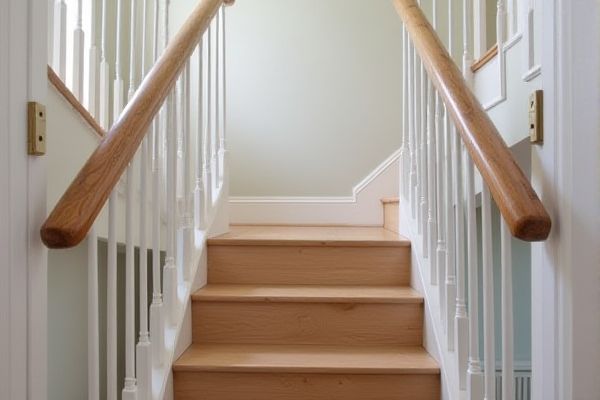
A mono stringer staircase features a single central support beam, creating a sleek, modern aesthetic with open sides, while a double stringer staircase has two side beams offering greater stability and a traditional look. Discover which staircase design best suits Your space and style by exploring the full article.
Table of Comparison
| Feature | Mono Stringer Staircase | Double Stringer Staircase |
|---|---|---|
| Structure | Single central support beam | Two parallel side support beams |
| Design Aesthetic | Sleek, minimalistic, modern look | Traditional, sturdy appearance |
| Load Capacity | Moderate; suitable for light to medium loads | High; supports heavier loads effectively |
| Installation Complexity | More complex; requires precise engineering | Relatively simpler assembly |
| Space Efficiency | Optimizes space, ideal for tight areas | Requires more space due to dual beams |
| Maintenance | Harder to access central stringer for repairs | Easier maintenance with accessible side beams |
| Common Materials | Steel, wood, or engineered composites | Wood, steel, concrete |
Introduction to Mono Stringer and Double Stringer Staircases
Mono stringer staircases feature a single central support beam that runs beneath the treads, offering a minimalist and open design ideal for modern interiors. Double stringer staircases use two parallel support beams on either side of the treads, providing enhanced structural stability and a traditional appearance. The choice between mono and double stringer often depends on architectural style, load requirements, and space constraints.
Design Overview: Mono vs Double Stringer Stairs
Mono stringer stairs feature a single central support beam that offers a sleek, minimalist design ideal for modern interiors, maximizing open space and light flow. Double stringer stairs use two outer beams providing robust structural support, suitable for heavier loads and traditional aesthetics that emphasize symmetry and stability. Your choice between these designs will influence the staircase's visual impact, durability, and installation complexity.
Structural Strength and Stability Comparison
Mono stringer staircases feature a single central beam supporting the treads, offering a sleek, minimalist design but potentially less lateral stability compared to double stringer staircases. Double stringer staircases utilize two parallel beams on either side of the steps, enhancing structural strength and providing superior resistance to twisting and side loads. For Your project, selecting a double stringer design ensures increased stability and load-bearing capacity, especially for high-traffic or heavy-use environments.
Aesthetic Appeal: Modern vs Traditional Styles
Mono stringer staircases offer a sleek, minimalist aesthetic favored in modern architectural designs, emphasizing clean lines and open space. Double stringer staircases provide a more traditional appearance with visible supports on both sides, adding a sense of solidity and classic craftsmanship. The choice between mono and double stringers significantly impacts the visual style, aligning with either contemporary or conventional interior themes.
Space Utilization and Layout Considerations
Mono stringer staircases maximize space utilization by providing a sleek, minimalist design with a single central support, allowing more open floor area beneath and around the stairs. Double stringer staircases feature two side supports, which may reduce usable under-stair space but offer enhanced structural rigidity and a more traditional appearance. Your choice between the two should consider the surrounding layout and desired openness to optimize both functionality and aesthetic appeal in your space.
Installation Process: Complexity and Time
The installation process of a mono stringer staircase is generally simpler and faster due to its single central support beam, which requires fewer components and less precise alignment compared to a double stringer design. In contrast, a double stringer staircase demands more complex assembly with two parallel support beams, increasing installation time and requiring skilled labor to ensure stability and symmetry. Your choice between the two will impact project duration and complexity based on the structural demands and aesthetic outcomes you desire.
Material Options and Durability
Mono stringer staircases typically use steel, timber, or concrete, offering streamlined modern aesthetics with high tensile strength and resistance to deformation. Double stringer stairs often incorporate robust materials like hardwood, steel, or aluminum, providing enhanced structural support and superior load distribution for increased longevity. Material selection for both types directly influences durability, with steel offering corrosion resistance and timber requiring treatment for moisture and wear protection.
Safety Features and Building Code Compliance
Mono stringer staircases enhance safety by providing a central support beam that evenly distributes weight, reducing structural movement and minimizing the risk of instability. Double stringer staircases offer increased lateral stability due to side-mounted supports, which align with stringent building code requirements for load-bearing capacity and handrail integration. Both designs must adhere to local safety codes ensuring proper tread width, riser height, and secure handrails to optimize user safety and structural integrity.
Cost Factors: Budgeting for Your Staircase
Mono stringer staircases typically cost less due to reduced material and simpler construction, making them a budget-friendly option for smaller spaces or modern designs. Double stringer staircases involve more materials, labor, and structural support, increasing overall expenses but offering greater durability and design versatility. Balancing your staircase budget requires considering both upfront cost differences and long-term maintenance needs.
Choosing the Right Stringer: Factors to Consider
Choosing the right stringer for a staircase depends on load-bearing capacity, aesthetic preference, and space constraints. Mono stringer stairs offer a sleek, modern look with minimal visual obstruction, ideal for open spaces but typically support less weight than double stringers. Double stringers provide enhanced structural stability and are suitable for heavy traffic areas or wider staircases where additional support is necessary.
 homyna.com
homyna.com